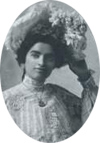Kate Barnard
Kate Barnard was born in Alexandria, Nebraska in 1875. She lost her mother at the age of two and moved to Oklahoma with her father. She lived in Nowall on a farm south of Oklahoma City. Her father moved to Oklahoma City to earn his living and Kate stayed back and worked on the farm. It was at this time that she saw poverty in families that lived around her on the farm. She noticed that children were being put to work at very young ages and were subjected to all kinds of hard labor.
In 1904 Kate witnessed her first big city slum and its awful conditions while attending the St. Louis World Fair. During the fair, Kate served as a hostess and booster for Oklahoma Territory at the Louisiana Purchase. In 1906 Kate returned to Oklahoma and studied corrective social legislation and then lobbied for education and the creation of Department of Charities and Corrections. The next year she was elected to the position of commissioner of Charities and Corrections, wining more votes than any other candidate including Oklahoma's first Governor Haskell. She was the first woman to win a statewide elective office in the United States. She was re-elected in 1911 for her second term with even more of the majority of votes.
Kate Barnard played an important role in the history of Oklahoma corrections. As commissioner of Charities and Corrections, Kate had received numerous complaints about the mistreatment of Oklahoma inmates in the Kansas Penitentiary. Kate arrived to the Kansas institution unannounced in August of 1908 and took a tour of the facility. What she found was torture of the inmates by the use of the "crib" and the "waterhose". When she returned to Oklahoma she wrote a report that recommended all Oklahoma prisoners be brought back to Oklahoma. This all happened within two months after her visit.
Kate wanted to wean the offenders away from their old habits and restore them to society as useful citizens. During the move, the prisoners maintained good behavior. None of them escaped. Maybe they were just happy to be rescued from the torture of Kansas prison.
In Kate's annual report, she recommended that merit marks for good behavior of the inmates. When an inmate has earned enough merit marks to earn one-third of the sentence, they should go before the Court of Rehabilitation for release on parole. She said she was "trying to preserve the right of a prisoner to become a better man." She also emphasized that the system must provide every possible incentive for the inmate to improve.
During her tenure, several laws were revised. They were:
Revised Laws of Oklahoma 1910, Volume I
• Sec. 4612: Penalty was prescribed for cruelty to convicts
• Sec. 4613: Penalty was prescribed for annoying convicts
• Sec. 4639: Governor may restore citizenship to an offender after expiration of sentence or after pardon.
Born: Geneva, Nebraska, May 23, 1875
Died: Oklahoma City, OK, 1930
Source:
http://www.doc.state.ok.us/DOCS/dochist/Hist0100.htm
Biography submitted by Juile Tarpley, HR student, Fall 2005. Julie writes "The reason I chose Kate is because of her practice in human relations by trying to help the inmates get rehabilitated back into society. Also her willingness as an advocated to stop mine working and her love for education and children as the article describes. The word limit kept me from writing about everything she accomplished. " |

